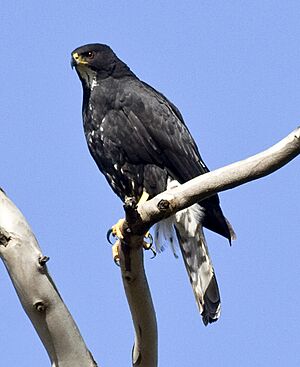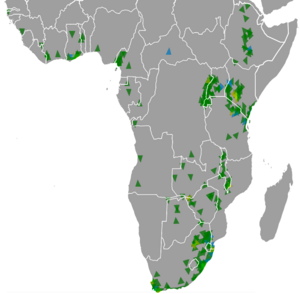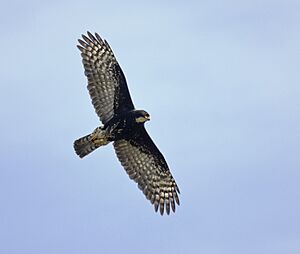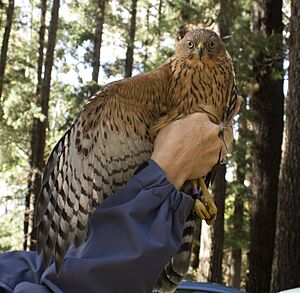Black sparrowhawk facts for kids
Quick facts for kids Black sparrowhawk |
|
|---|---|
 |
|
 |
|
| Adult females of the light and dark morphs respectively | |
| Conservation status | |
| Scientific classification | |
| Genus: |
Accipiter
|
| Species: |
melanoleucus
|
| Subspecies | |
|
|
 |
|
| global range Year-Round Range Summer Range Winter Range | |
The black sparrowhawk (Accipiter melanoleucus) is a large bird of prey found in Africa. It is also known as the black goshawk or great sparrowhawk. This bird is the biggest type of True hawk in Africa.
You can find black sparrowhawks mostly in forests and areas that are not deserts, south of the Sahara desert. They especially like places with big trees where they can build their nests. They also live in towns and areas changed by humans. These hawks mainly hunt medium-sized birds, like pigeons and doves, especially in city areas.
Contents
What are Black Sparrowhawks?
Black sparrowhawks belong to a group of birds called Accipiter. There are two main types, or subspecies, of black sparrowhawks. One is called Accipiter melanoleucus melanoleucus, named by A. Smith in 1830. The other is Accipiter melanoleucus temminckii, named by Hartlaub in 1855.
Both subspecies live in different parts of Africa. They are part of the Accipiter genus, which is in the Accipitridae family. This family also includes other well-known birds like hawks and eagles. All these birds are part of the Accipitriformes order.
How to Describe a Black Sparrowhawk?
Most black sparrowhawks have mostly black feathers, called plumage. They have a white throat, chest, and belly. These birds are known as "white morphs" and are the most common type.
There is also a "black morph" type, which is usually rare. However, along the coast of South Africa, especially near Cape Peninsula, about 80% of these birds are black morphs. When a black morph bird is sitting, it can look completely black. But often, it has a few white spots on its chest or a white throat.
When flying, both types of birds show black and white stripes under their wings and tail. Black morphs are not completely black from birth. Their legs are yellow, and they have large feet and sharp talons.
Young Black Sparrowhawks
Baby black sparrowhawks, called chicks, have mid-grey eyes and white fluffy down feathers. As they grow, their feathers become mostly brown. Young birds have brown and reddish-brown feathers with dark stripes on their head and chest. They often have white spots and streaks on their wings.
The brown feathers of young birds help them avoid aggressive older birds. As they get older, their eye color changes from mid-grey to light brown, and then to dark red.
How Big are They?
The black sparrowhawk is one of the largest Accipiters in the world. Only a few other goshawks, like the Henst's, Meyer's, and Eurasian goshawk, can be as big or bigger.
Like many Accipiters, male black sparrowhawks are smaller than females. Males usually weigh between 450 and 650 grams. Females are heavier, weighing from 750 to 1020 grams. The total length of a black sparrowhawk is about 50 cm, and their wingspan is about 1 meter.
They have long tails (about 25 cm) and long legs (about 8 cm). These features help them fly through thick trees. Even though they can fly through dense areas, they mostly hunt in open spaces, often from a hidden spot in a tree.
Different Colors of Black Sparrowhawks
Black sparrowhawks come in two different colors: light and dark. This color difference is passed down through their genes, like how eye color is passed down in humans. The gene for the light color is usually stronger, or dominant.
The number of dark-colored birds changes across South Africa. More than 80% are dark in the Cape Peninsula, but less than 20% are dark in the northeast. This color difference does not seem to be affected by how many buildings are in an area.
Dark-colored black sparrowhawks might be more common in the Cape Peninsula because their dark color genes also help them in another way. These genes might make them better at fighting off blood parasites. In the Cape Peninsula, black sparrowhawks breed during the wet season. During this time, biting insects that carry these parasites are more common. So, being dark-colored gives them an advantage there.
When black sparrowhawks breed in the Cape Peninsula, pairs with one light and one dark parent have more babies each year. However, these babies might not be as healthy.
It has also been noticed that dark-colored black sparrowhawks hunt better when there is less light. Light-colored birds catch more prey when it's brighter. This suggests that each color helps them hide better from their prey in different light conditions.
Where Do They Live?
Black sparrowhawks are common in Africa, south of the Sahara desert. They are not considered a threatened species. In some places, like Kenya, you might find one pair of birds in every 13 square kilometers. In South Africa, it's one pair per 38 to 150 square kilometers. But in the Cape Peninsula, nests can be as close as 500 meters apart in pine forests.
Both types of black sparrowhawks live only in sub-Saharan Africa. A. m. temminckii lives in the northwest, including Senegal and the DRCongo. A. m. melanoleucus is found from northeastern Africa down to South Africa.
They naturally live in patches of forest, rich woodlands, and areas along rivers that extend into dry bush. They can live in many places as long as there are large trees, even in mangrove forests in coastal Kenya. In southern Africa, they have learned to live in forests of non-native trees like eucalyptus, poplar, and pine. These trees can grow much taller than native trees.
Black sparrowhawks can adapt to new forests and farmed areas. They are often seen near homes. This is why they are not as affected by deforestation as many other African forest birds. Their numbers might even grow in areas where these new trees have been planted in open country. They can be found from sea level up to 3700 meters high.
In some areas, especially the Cape Peninsula, these sparrowhawks have trouble with Egyptian geese. These geese are aggressive and sometimes steal the sparrowhawks' nests. This can be a big problem for the sparrowhawks, as they spend a lot of time and energy building their nests. It can even lead to the death of their young. However, sparrowhawks sometimes have more than one nest. If one is stolen, they might build a new one nearby or wait until the geese leave.
Living in Cities
Black sparrowhawks have also moved into cities and suburbs of Cape Town in South Africa. They have done very well there in recent years. They don't seem to be harmed by the changes in weather or other stresses of city life. This is probably because there is a lot of food for them in cities, mainly different kinds of pigeons and doves. So, they don't have trouble finding enough to eat.
Living in cities does not negatively affect how well they breed. Black sparrowhawks in cities are more successful at breeding early in the season. Birds in less urban areas do better later in the breeding season.
What Do Black Sparrowhawks Do?
Their Sounds
Black sparrowhawks are usually quiet, except when they are breeding. Males make short, sharp "keeyp" calls when they bring food. Females answer with lower "kek" sounds. Before the male brings food, the female will make loud, high-pitched "kweeeeee-uw" sounds to ask for food. Both male and female birds make alarm calls and mating calls. Young birds, especially older ones, are very noisy. They make high-pitched "weeeeeeeeh" sounds, especially when they want food.
What They Eat
Black sparrowhawks mainly eat medium-sized birds. They usually spot their prey from a hidden spot in a tree. Then, they quickly fly out and catch the bird in the air. Sometimes, they swoop down or chase prey they see while flying low or high over open areas. They might even chase prey on the ground.
Most hunts are over in less than a minute. But sometimes, they might chase a bird for several minutes. They have been known to look for ant swarms to catch birds that are attracted to the ants. Most birds they hunt weigh between 80 and 300 grams.
Males mainly eat doves. Females often catch larger prey like pigeons and francolins. They also eat chickens found in villages. They often hunt rock pigeons, which have become common because of cities and towns. Black sparrowhawks have adapted well to changes in their habitat, like new forests and cities, by hunting the growing numbers of doves and pigeons. They sometimes hunt other birds of prey, like shikras and owls. Very rarely, they might eat small mammals, such as bats, rodents, and young mongooses. Black sparrowhawks can carry their prey, after plucking and removing the head, for up to 12 kilometers. They usually fly high above the trees.
How They Reproduce
The A. m. temminckii subspecies usually breeds between August and November. The A. m. melanoleucus subspecies breeds between May and October. In Zambia, they breed from July to February. Black sparrowhawks in eastern Africa seem to breed almost any time of the year.
These birds are very careful about where they build their nests. They prefer spots inside the tree canopy to protect their young from bad weather and other predators. Nests have been found from 7 to 36 meters high in trees. Very rarely, they might be on the ground between large tree trunks. However, nests are usually not deep inside the forest. This helps them stay close to their hunting areas outside the forest.
The nests are made of thousands of sticks collected by both parents. They are usually lined with green leaves from eucalyptus or pine trees, or camphor leaves. These aromatic leaves might help keep away disease-carrying creatures like mites and insects. The nests can be 50 to 70 cm wide and 30 to 75 cm deep.
Black sparrowhawks form pairs that stay together, called monogamous pairs. However, sometimes they might mate with other birds. A pair will mate often throughout the breeding season, starting during courtship and continuing even after the chicks have learned to fly. Once they start building or fixing the nest, the female becomes less active. The male then does almost all the hunting and brings food for the female and the chicks when they hatch.
The female usually lays 2 to 4 eggs. The pair will sit on them, or incubate them, for about 34 to 38 days until they hatch. The female does most of the incubating. But the male will take over after he brings food. The female will then eat, maybe bathe in a nearby stream, and then go back to incubating. This continues even after the chicks hatch. The female will intensely care for the chicks for up to 21 days. After that, she might start hunting for food too, but only if the nest is safe from other predators. She remains the main protector of the nest and the chicks.
Newly hatched chicks are covered in white down feathers. They cannot leave the nest because they need their parents for food, warmth, and protection. After 37 to 50 days, the young birds learn to fly, or fledged. But the parents will keep caring for them for another 37 to 47 days. So, the whole process, from laying eggs to the young birds becoming independent, can take about 20 weeks, or 5 months.
Black sparrowhawks are known to sometimes try to raise more than one group of chicks in a season. This is very rare for birds of prey. The second group of chicks might be raised in the same nest or in another nest nearby. The older chicks from the first group will still be fed by the parents. In the Cape Peninsula, South Africa, they also build multiple nests in a season. This behavior is thought to help them deal with Egyptian geese stealing their nests.
Nests are usually used again year after year, often by the same pair. One nest is known to have been used continuously for 32 years by different pairs of birds.





